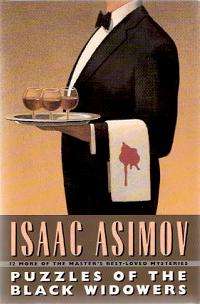Puzzles of the Black Widowers
Puzzles of the Black Widowers is a collection of mystery short stories by American author Isaac Asimov, featuring his fictional club of mystery solvers, the Black Widowers. It was first published in hardcover by Doubleday in January 1990, and in paperback by Bantam Books the same year. The first British edition was issued in hardcover by Doubleday (UK) in April 1990, and the first British paperback edition by Bantam UK in April 1991.[1]
 Cover of first edition, 1990 | |
| Author | Isaac Asimov |
|---|---|
| Cover artist | James Steinberg |
| Country | United States |
| Language | English |
| Series | Black Widowers |
| Genre | Mystery |
| Publisher | Doubleday |
Publication date | 1990 |
| Media type | Print (hardcover) |
| Pages | 253 pp |
| ISBN | 0-385-26264-7 |
| OCLC | 19625924 |
| 813/.54 20 | |
| LC Class | PS3551.S5 P8 1990 |
| Preceded by | Banquets of the Black Widowers |
| Followed by | The Return of the Black Widowers |
This book is the fifth of six that describe mysteries solved by the Black Widowers, based on a literary dining club he belonged to known as the Trap Door Spiders.[2] It collects twelve stories by Asimov, nine reprinted from mystery magazines and three previously unpublished, together with a general introduction and an afterword by the author following each story. Each story involves the club members' knowledge of trivia.
Contents
- Introduction
- "The Fourth Homonym" (1985)
- "Unique Is Where You Find It" (1985)
- "The Lucky Piece" (1990)
- "Triple Devil" (1985)
- "Sunset on the Water" (1986)
- "Where Is He?" (1986)
- "The Old Purse" (1987)
- "The Quiet Place" (1988)
- "The Four-Leaf Clover" (1990)
- "The Envelope" (1989)
- "The Alibi" (1989)
- "The Recipe" (1990)
Notes
- Puzzles of the Black Widowers title listing at the Internet Speculative Fiction Database
- Asimov 1994, I. Asimov, chapter "120. The Trap Door Spiders".
External links
- Puzzles of the Black Widowers title listing at the Internet Speculative Fiction Database
- Puzzles of the Black Widowers at Open Library